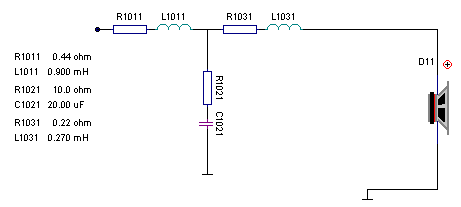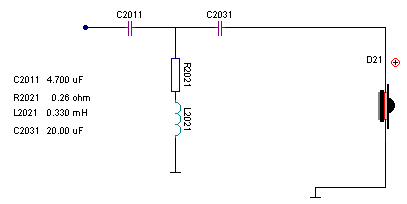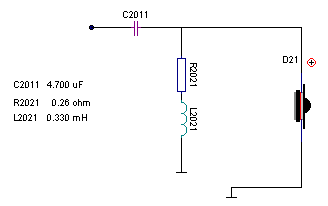|
The Radio Shack LX550 is the third generation of a design that combines a 5" woofer with the dipole Linaeum tweeter. The regular price is $300 a pair, and they certainly are not worth that. But on a regular basis, Radio Shack cuts the price in half, and then many are prompted to give them a try to see what the unique tweeter sounds like. In the current generation, the answer is "not much." The high end of the tweeter is overwhelmed by a too-prominent midrange, caused by a woofer peak and too much overlap between the woofer and tweeter output.
Here are two modifications that solve the overlap problem, but don't do much about the woofer peak at 1.5kHz. The sound is a little more forward in the midrange than I would like, but the tweeter gets a chance to show what it can do. The sound improves from a B-/C+ to a B+/B (no grade inflation here). The first version changes the simple first order electrical network to a third order, with fourth-order LR acoustic slopes. The crossover frequency is 2.2 kHz. The second and simpler version eliminates the third leg in the low pass and high pass, for a second order electrical circuit. The sound with the simpler network is a little rougher in the mid treble, but it's not a big difference. It also loses much of the steep reverse null at the crossover frequency that the full third order crossover provides. But we are talking steeply diminishing returns, and you may well want to keep it simple.
If you try either crossover, remember that the stock version wires the tweeter with reverse polarity. So don't get confused -- the blue wire is really the tweeter positive, and the black is negative. Both of my crossovers use direct tweeter polarity. Remember to lay out the new board so that you don't have a capacitor or coil blocking the port. Think ahead. Finally, both revised crossovers use the existing .9 mH inductor to keep cost down and preserve interior volume. If you decide to replace the high gauge stock coil, increase the value to 1.0 mH. That will reduce the midrange a tiny bit. Component quality is up to you, but I would just use mylar for the two big 20 uF caps.
Here is the low pass filter for the full version (remember -- the resistor values before the inductors are just the recommended dcr value, they aren't real resistors!):

Here is the high-pass filter:

Here is the low-pass for the scaled down version:

And the corresponding high-pass:

Here are the measurements. |

